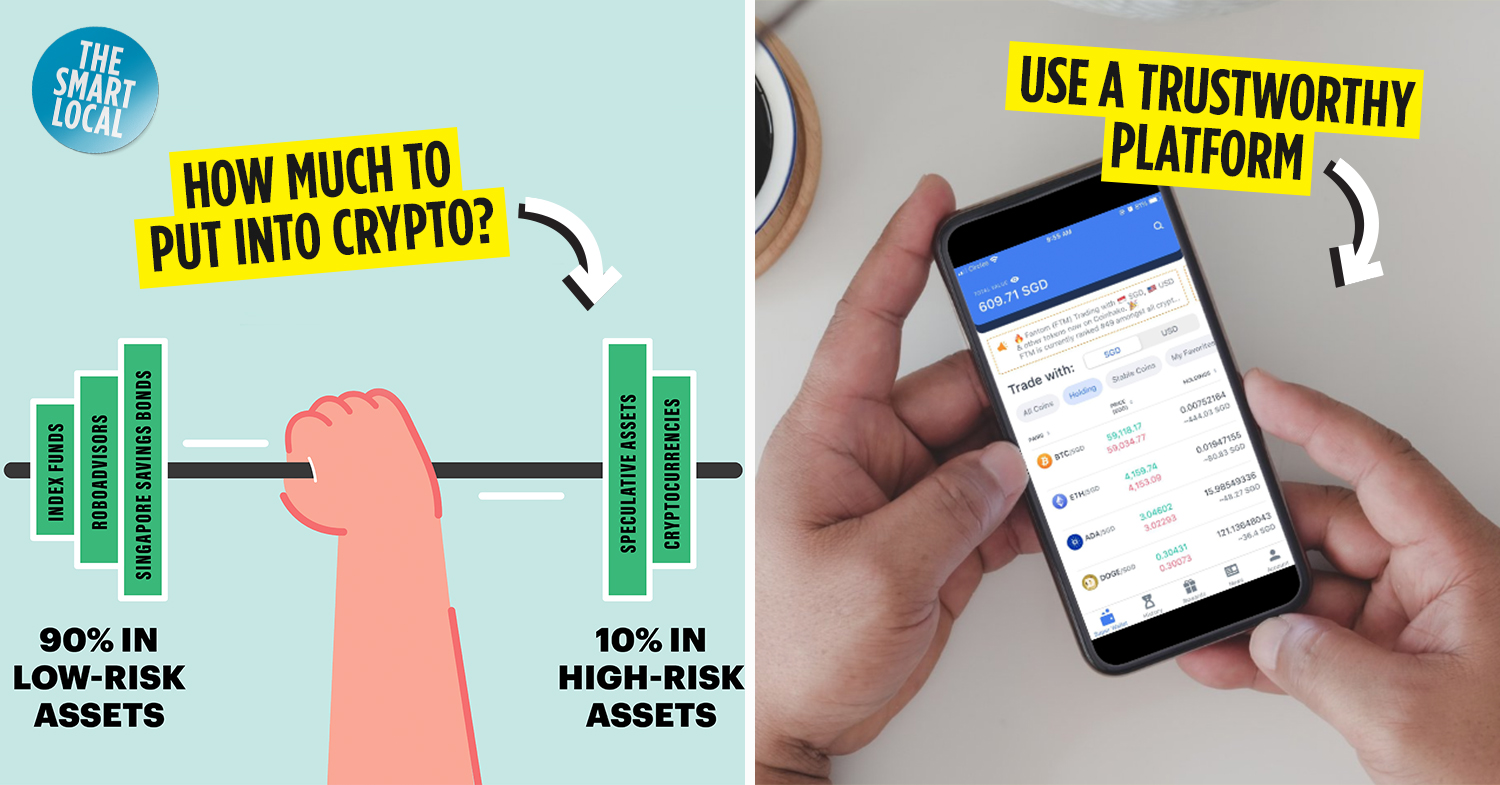Investing in cryptocurrency for beginners
Everyone thinks about adulting like it’s a great “aha!” moment where we evolve into more mature, capable versions of our teen selves. Unfortunately, the truth is far more boring. We start realising what we were doing badly as young adults, and what we need to do to be better versions of ourselves.
This, for me, meant taking charge of my finances.
My crypto journey began when I started thinking about buying a house. Housing in Singapore is expensive, and although I had thought myself “financially stable” because I always had savings at the end of every month, the moment I sat down to do the sums for housing, I realised how far away I was from my goals.
Tips for investing in cryptocurrency
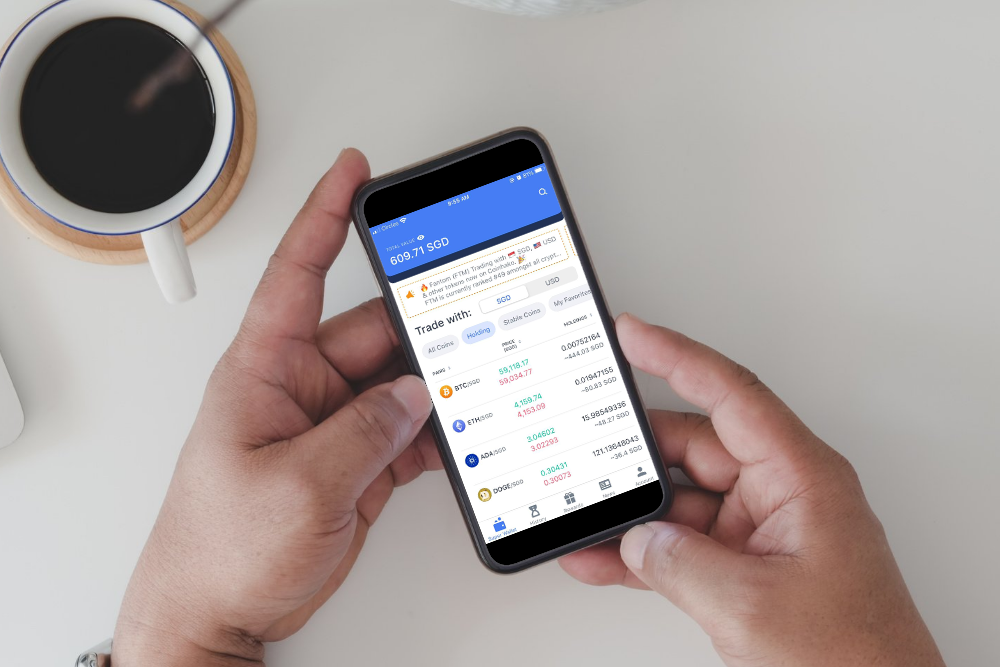
While I did have some experience in the stock market, I only started dabbling in crypto and investments this year, at the ripe age of 32. In hindsight, a little too late. Thankfully, there are always opportunities in the crypto space that offer higher rewards than others – if we’re willing to put in effort in researching what’s out there.
While the crypto market’s volatility can be intimidating, if you’re new to the whole ballgame, there are a few recent developments that should ease your worries: Visa just bought a NFT for US$150,000 and Apple is reported to be starting a cryptocurrency division.
And if there’s one thing being in the stock market has taught me, it’s that when smart money leads, I should follow. After having done my due diligence, of course.
Lesson 1: Limit your risks with the Barbell strategy
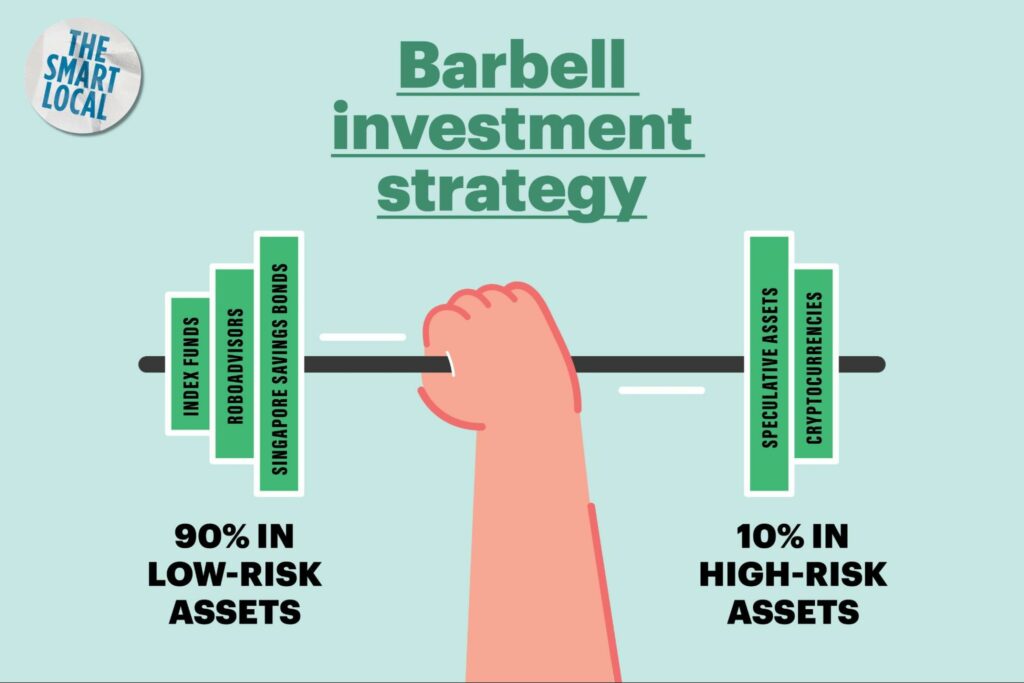
While I’m in no way a financial advisor, there are general wealth-creation principles you can follow to ensure you safeguard your monies. The first is to recognise how much risk you’re willing to take and put a number to it.
The Barbell strategy is one way to quantify this. Essentially, it says to keep 90% of your investment portfolio in extremely safe assets, while taking risks with 10% of it. If you adopt this strategy with a portfolio of $10,000, this means to invest $9,000 into an index fund or a low-risk roboadvisor, while 10% goes into higher-risk investments like crypto.
This keeps your portfolio largely safe, while retaining exposure for your high risk investments to capture outsized gains. The 90/10 allocation isn’t fixed. The younger you are, the more you can tilt your portfolio towards higher risk asset allocation. I have friends in university who have 80% of their portfolio in crypto, although that’s not a portfolio allocation I’d recommend for anyone above 30 years old.
After all, the older we get, the more responsibilities we start to take on. Especially if you’re saving up for a wedding, house or have a family to provide for.
TLDR: Know your risk appetite. If you’re risk-averse, then keep 95% of your portfolio in safe harbour assets like Singapore Savings Bonds, while investing 5% in high-risk-high-returns assets.
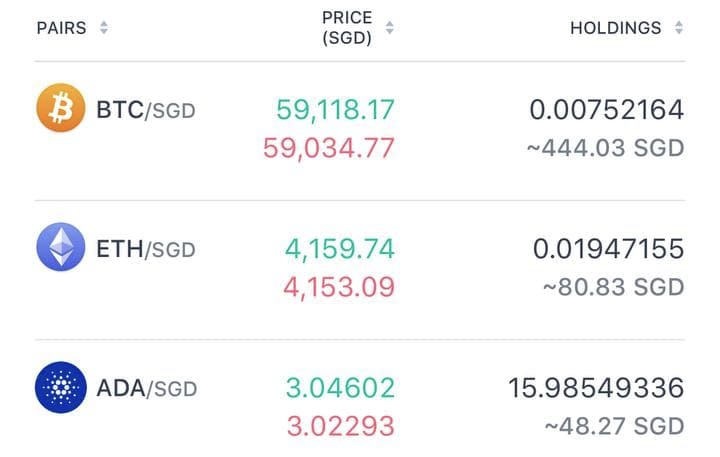
As a rule of thumb, the “safest” names in crypto are the ones everyone knows: Bitcoin (BTC), Ethereum (ETH), and Cardano (ADA). This isn’t an endorsement, but it’s a good starting point to do your research.
Image adapted from Coinhako
Beginner tip: Consider dollar cost averaging as a long-run strategy
Cryptocurrency platforms like Coinhako allow you to make cash transfers straight from your bank account to buy Bitcoin or Ethereum. You can use this to make frequent transfers, like S$100 a week or month.
This is called Dollar Cost Averaging (DCA), and is widely acknowledged as the most efficient way to accumulate your investments. Instead of getting stressed out because you’re unsure if you’re buying at a “good” or “bad” price, you average out your buy prices over time, thereby capturing steadier gains.
Lesson 2: Do your research. Every crypto sounds amazing in a vacuum
The first cryptocurrency I bought was Bitcoin. It has the best name recognition, being the first-ever cryptocurrency, and I saw it as a “safe” buy. After all, it’s the only cryptocurrency that an actual country (El Salvador) has declared an official currency, which means it’s legitimate… right?
As I started looking into it, however, I realised that while Bitcoin had many advantages, it also had competitors. Luna, Litecoin, and Nano, to name a few, are making moves into Bitcoin’s claim to fame as being a store of value, each offering unique takes on how cryptocurrencies should develop as digital currencies.
On its own, Bitcoin sounds like an incredible buy, but do your research and look at competitors to have a better understanding of the landscape. Then when you decide to make the purchase, you’ll know you’re making an informed decision.
Note: Ethereum, the second largest blockchain, is designed to be programmable money. Like Bitcoin, it also has competitors. Check out Cardano and Solana for a better understanding of the sector.
Lesson 3: Understand your strategy. Know if you are more of a trader or investor
Have a game plan before you enter the crypto market. There are two classes of people in the stock market: the trader and the investor.
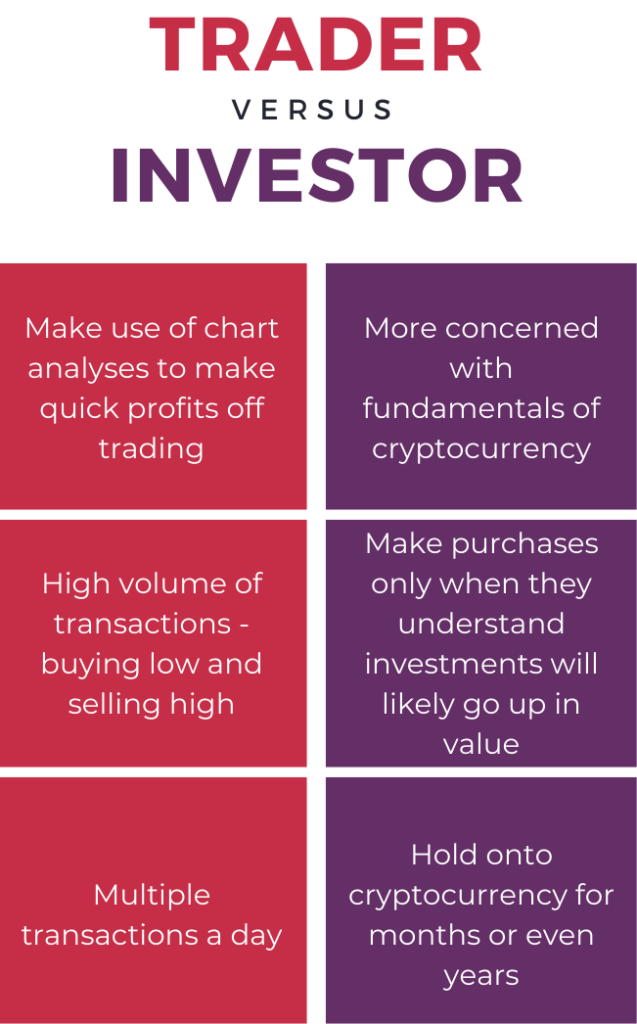
Be sure of which class you’re more comfortable in and stick to it.
If you’re a trader, sticking to volatile cryptocurrencies would be beneficial, as there’s a greater probability of you scalping higher profits.
Trader-specific tips:
- Learn how to read a chart and understand Technical Analysis
- Remember to withdraw your profits when you make profits
- Memecoins, like Dogecoin, are good playgrounds because they’re driven by speculation
If you’re an investor, you must have conviction in the coins you pick.
- Understand the vision and roadmap of the team developing the coin
- Don’t be spooked by sudden price changes
- If the crypto’s underlying principles don’t change, hold on to them
- The exact purchase price of the cryptocurrency doesn’t matter as much
- If you’re confident a coin’s price will rise to $10, it won’t matter as much if you buy it for $3.20 or $3.23
Lesson 4: Find your own trusted sources of information
Coin Bureau provides relatively neutral takes on crypto in digestible pieces
Watch any YouTube videos or read any articles on crypto, and you’ll find they mostly include the same disclosure: “not financial advice” or “NFA”. Your money is your own, and no matter how hyped influencers are online, they’re not going to share responsibility for any money you lose.

Elon Musk’s Tweet on Dogecoin is what skyrocketed the cryptocurrency’s value overnight.
Remember that when an influencer talks about a crypto they’ve bought – it’s because they’ve already bought it, and the more people buy the same crypto, the more the demand will push its price up. There are snake oil salesmen in the space who are out to make a quick buck, and you need to know who to trust. Plus, if everyone’s already talking about it, there’s a chance the coin may be overpriced.
As an investor, I use crypto influencers as a starting point for research, then finding out on my own which projects sound interesting before diving deeper into them. I’ll check Twitter, YouTube and forums to shortlist cryptocurrencies, then read the projects’ White Papers before deciding if I plan to invest in them.
Lesson 5: Find an area of crypto to specialise in – NFT, DeFi, games
Speaking of keeping up with the latest developments, there are far too many blockchains and cryptocurrencies for a single person to keep up with.
The three biggest spaces that have developed so far are NFTs (Non-Fungible Tokens), DeFi (Decentralised Finance) and crypto games. I’ve stayed away from NFTs and games, focusing instead on DeFi, like Ethereum.
As it’s still a relatively new market, new crypto use cases are likely to pop up over time. It may be best to concentrate on a single area to maximise gains when the time comes. Don’t be seduced by quick gains – focus on what you know, keep your patience, and strike when the iron is hot.

The creator of the Nyan Cat animated gif turned his artwork into an NFT and sold it for 300 Ethereum tokens
Image credit: Foundation
While Bitcoin was the first cryptocurrency I bought, I’ve developed a strategy to bypass it completely. After all, the name of the game is to buy the “right” coins, and each person has to determine what “right” means.
While I believe Bitcoin will be the last coin standing in 50 years, there are other opportunities in the market. Find your niche – if you like games, look at the latest play-to-win crypto games. If you like art, look at NFTs. If you like understanding complex financial systems like me, look at DeFi.
I’m comfortable saying that each sector has tokens that will outperform Bitcoin – but only if you pick correctly.
Lesson 7: Be wary of crypto scams
We’ve seen enough Singapore Police Force banners about WhatsApp scams to know that the internet is not a friendly space. It is in that vein that you need to know that there are bad actors online who are out to get your money.
To avoid being scammed, here are a few things you can do:
- Use platforms with a good track record and reputation like Coinhako
Not all gateways to cryptocurrencies are made equal. If you read the news, you’ll know that some platforms have been disciplined by regulators in Singapore, and you’ll want to keep your risk levels down.
Pick platforms that have built a strong track record over the years. A handful of companies have remained steady over the years and grown to be key service providers for cryptocurrency products today.
They also serve multiple functions, including listing legitimate coins, ensuring that the highest levels of safety (including 2FA) are in place for their customers.
- Independently verify all information
Don’t rush into making decisions. Always make sure to independently verify the latest news, and if a “friend” asks you to send them anything, verify their identity through a video call before you do anything.
- Keep your seed phrases and sensitive information safe
If you decide to use a cold wallet, make sure to keep your seed phrase and/or passwords safe. Treat your seed phrase like your ATM passcode. You should never give it out to anyone who asks for it.
Never make it a habit to store such sensitive information in your email or on a cloud platform either. These are some of the most accessible ways for hackers to obtain key information.
Lesson 8: Pick the right crypto projects
Red flags are usually easy to spot. Projects that scream 3000% returns or are created by shadowy teams should be avoided as much as possible. To end on a strong note, however, let’s look at some green flags:
- Make sure they have a White Paper
The most basic requirement for a project to be considered is its White Paper. A White Paper is where a project is outlined, from how its tokens are distributed to what the cryptocurrency is meant to do.
While most White Papers are too dense to read, I make it a point to dive deep into projects I buy into long term. Some things I look out for are if the cryptocurrency provides an adequate solution to an existing problem that only a blockchain system can fix, or if the project was created just “for fun” or “for price speculation”.
Examples of solid White Papers: Bitcoin, Ethereum, Chainlink
- Communities that talk about developments rather than price
Many projects are launched to make a quick buck. I prefer projects that were launched to change the world. The latter are likely to have communities that are focused on building the ecosystem, and are incentivised to stay beyond quick price changes.
- Strong leadership
Perhaps the most important component to seeing if a project is legitimate: check out the reputation of the leaders. There are some leaders who have already made names for themselves, and any project that works with them is more likely to be legitimate.

Charles Hoskinson was a co-founder of Ethereum and worked on the project for two years before stepping down to create Cardano, as he had a different vision for funding cryptocurrency.
Image credit: @bitcoinangola1
If Tim Cook was to step down from Apple and take over at a small company, you bet I’d be watching what the company does very closely.
Get started on cryptocurrency with Coinhako
I started my journey in a stocks investing class, and I will always remember the most useful piece of advice offered by the instructor: “just buy a bit, won’t die one”.
Those were the words that spurred me to buy my first Apple stock, just as they were the words that got me to sink my first $10 into Bitcoin. Get your budgeting done first, know how much you’re willing to put into the high-risk portion of your portfolio, then develop a strategy for it.
Coinhako was the first cryptocurrency platform I used, and there are a few reasons why. Firstly, it’s founded in Singapore, which affords it greater legitimacy in my mind. Secondly, it’s gamified, with points given for each day you log into the app. These points can be used to offset transaction fees and even get you some cryptocurrencies. Thirdly, Coinhako has a referral programme where I could earn 20% on trading fees every time a referred friend bought Bitcoin on the platform.

Log in daily to earn points that can be used to gain cryptocurrency for free
Image adapted from Coinhako
The Coinhako platform is really sleek, making it the most beginner-friendly on-and-off ramp platform for newcomers to crypto. You can buy, sell, and swap over 50 digital currencies here easily using fiat currency (SGD and USD), and they provide frequent updates on new token additions and promotions on social media. Plus, there are multiple modes of payment, from credit cards to bank transfers, or even USD stablecoin deposits for the more advanced crypto users.
They’re also the only platform I know of in Singapore that allows me to fund my account directly from the bank and support my DCA needs. If you’re the sort that prefers an efficient method of accumulating your crypto, that’s definitely the function to look out for.
If you’d like to explore crypto using Coinhako, here are two promo codes to use on your first three trades to get you started. Use TSLNEW to get 50% off trading fees when making transactions with the Singapore Dollar wallet, or use TSLCC to get 100% off trading fees using card payments.
Start your crypto journey with Coinhako
This post is brought to you by Coinhako.
Infographic by Huy Pham.
Disclaimer: This article is meant for information only and should not be relied upon as financial advice. Before making any decision to buy, sell or hold any investment or insurance product, you should seek advice from a financial adviser regarding its suitability.
This advertisement has not been reviewed by the Monetary Authority of Singapore.
